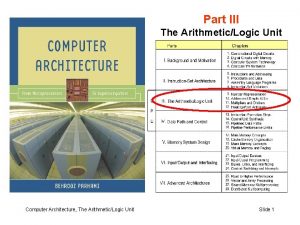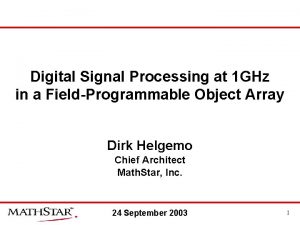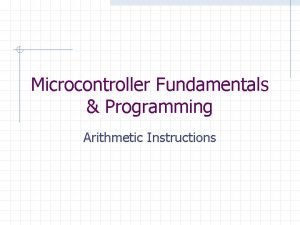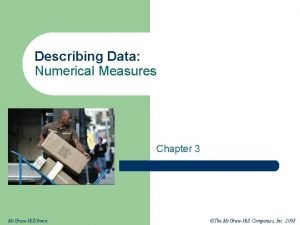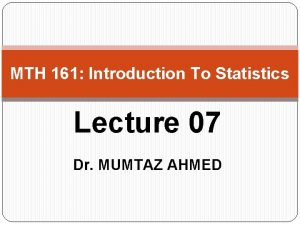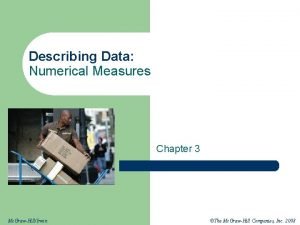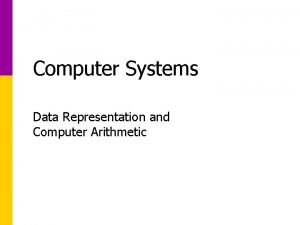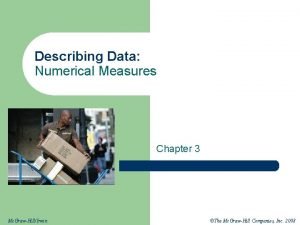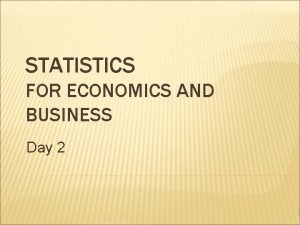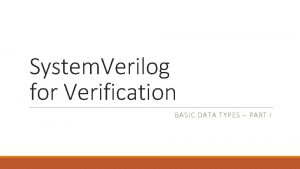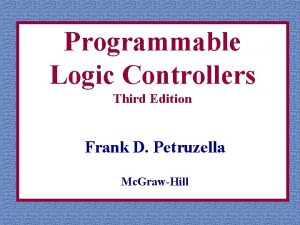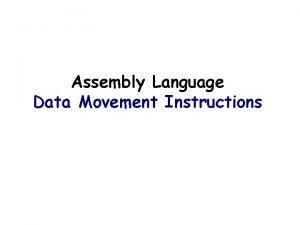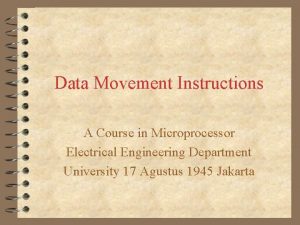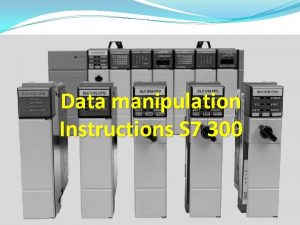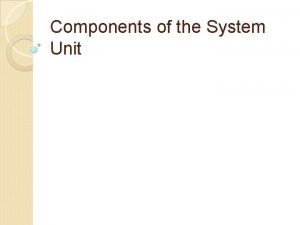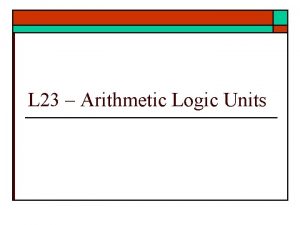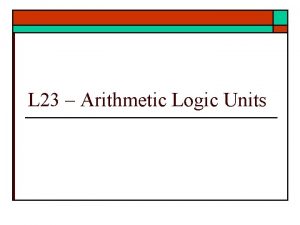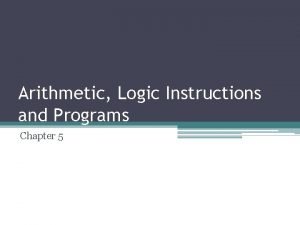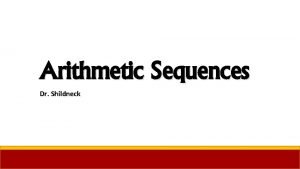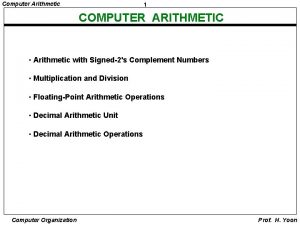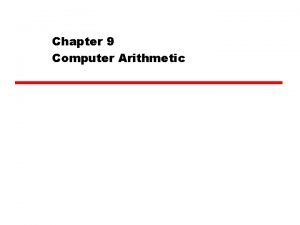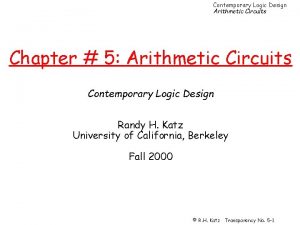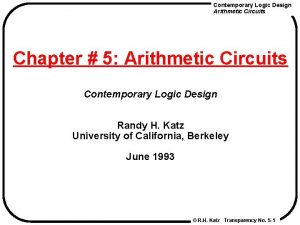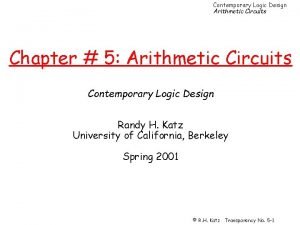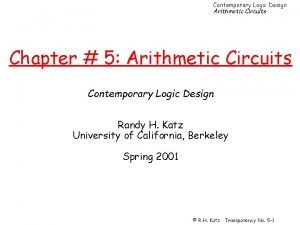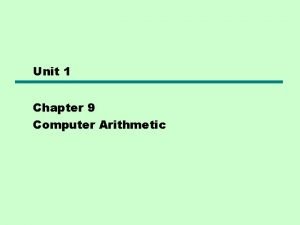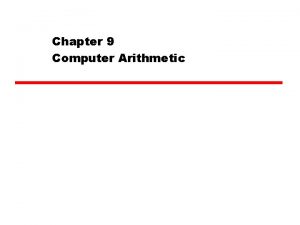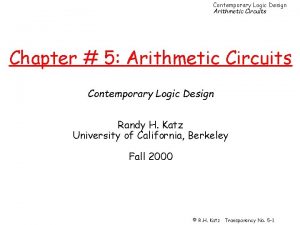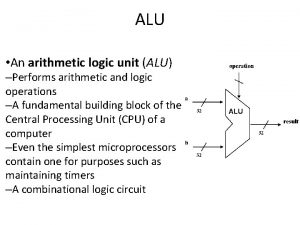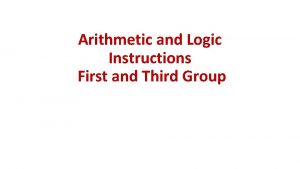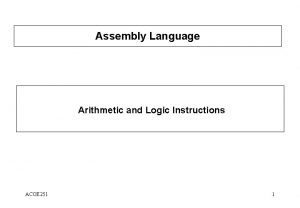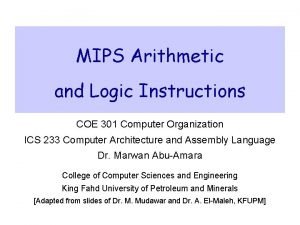Data Processing Instructions Arithmetic Instructions Logic Instructions Arithmetic









































- Slides: 41

Data Processing Instructions Arithmetic Instructions Logic Instructions

Arithmetic Instructions • • Add Subtract Increment Decrement Multiply Divide Decimal adjust

Arithmetic Instructions Mnemonic Description ADD A, byte add A to byte, put result in A ADDC A, byte add with carry SUBB A, byte subtract with borrow INC A increment A INC byte increment byte in memory INC DPTR increment data pointer DEC A decrement accumulator DEC byte decrement byte MUL AB multiply accumulator by b register DIV AB divide accumulator by b register DA A decimal adjust the accumulator

ADD Instructions add a, byte addc a, byte ; a a + byte + C These instructions affect 3 bits in PSW: C = 1 if result of add is greater than FF AC = 1 if there is a carry out of bit 3 OV = 1 if there is a carry out of bit 7, but not from bit 6, or visa versa.

Instructions that Affect PSW bits

ADD Examples • What is the value of the C, AC, OV flags after the second instruction is executed? mov a, #3 Fh add a, #D 3 h 0011 1101 0011 0001 0010 C = 1 AC = 1 OV = 0

Signed Addition and Overflow 2’s 0000 … 0111 1000 … 1111 complement: 0000 00 0 1111 0000 1111 7 F 127 80 -128 FF -1 0111 1111 (positive 127) 0111 0011 (positive 115) 1111 0010 (overflow cannot represent 242 in 8 bits 2’s complement) 1000 1111 1101 0011 0110 0010 (negative 113) (negative 45) (overflow) 0011 1111 (positive) 1101 0011 (negative) 0001 0010 (never overflows)

Addition Example ; Computes Z = X + Y ; Adds values at locations 78 h and 79 h and puts them in 7 Ah ; ---------------------------------X equ 78 h Y equ 79 h Z equ 7 Ah ; --------------------------------org 00 h ljmp Main ; --------------------------------org 100 h Main: mov a, X add a, Y mov Z, a end

The 16 -bit ADD example ; Computes Z = X + Y (X, Y, Z are 16 bit) ; ---------------------------------X equ 78 h Y equ 7 Ah Z equ 7 Ch ; --------------------------------org 00 h ljmp Main ; --------------------------------org 100 h Main: mov a, X add a, Y mov Z, a mov a, X+1 adc a, Y+1 mov Z+1, a end

Subtract SUBB A, byte subtract with borrow Example: SUBB A, #0 x 4 F ; A A – 4 F – C Notice that There is no subtraction WITHOUT borrow. Therefore, if a subtraction without borrow is desired, it is necessary to clear the C flag. Example: Clr c SUBB A, #0 x 4 F ; A A – 4 F

Increment and Decrement INC A increment A INC byte increment byte in memory INC DPTR increment data pointer DEC A decrement accumulator DEC byte decrement byte • The increment and decrement instructions do NOT affect the C flag. • Notice we can only INCREMENT the data pointer, not decrement.

Example: Increment 16 -bit Word • Assume 16 -bit word in R 3: R 2 mov a, r 2 add a, #1 mov r 2, a mov a, r 3 addc a, #0 mov r 3, a ; use add rather than increment to affect C ; add C to most significant byte

Multiply When multiplying two 8 -bit numbers, the size of the maximum product is 16 -bits FF x FF = FE 01 (255 x 255 = 65025) MUL AB ; BA Note : B gets the High byte A gets the Low byte A * B

Division • Integer Division DIV AB ; divide A by B A Quotient(A/B) B Remainder(A/B) OV - used to indicate a divide by zero condition. C – set to zero

Decimal Adjust DA a ; decimal adjust a Used to facilitate BCD addition. Adds “ 6” to either high or low nibble after an addition to create a valid BCD number. Example: mov a, #23 h mov b, #29 h add a, b DA a ; a 23 h + 29 h = 4 Ch (wanted 52) ; a a + 6 = 52

Logic Instructions q Bitwise logic operations v (AND, OR, XOR, NOT) q Clear q Rotate q Swap Logic instructions do NOT affect the flags in PSW

Bitwise Logic ANL AND ORL OR XRL XOR CPL Complement Examples: ANL 00001111 10101100 00001111 ORL 10101100 10101111 XRL 00001111 10101100 10100011 CPL 10101100 01010011

Address Modes with Logic ANL – AND ORL – OR XRL – e. Xclusive o. R a, byte direct, reg. indirect, reg, immediate byte, a direct byte, #constant CPL – Complement a ex: cpl a

Uses of Logic Instructions • Force individual bits low, without affecting other bits. anl PSW, #0 x. E 7 ; PSW AND 11100111 • Force individual bits high. orl PSW, #0 x 18 ; PSW OR 00011000 • Complement individual bits xrl P 1, #0 x 40 ; P 1 XRL 01000000

Other Logic Instructions CLR RL RLC RR RRC SWAP – – – clear rotate left through Carry rotate right through Carry swap accumulator nibbles

CLR ( Set all bits to 0) CLR A CLR byte CLR Ri CLR @Ri (direct mode) (register indirect mode)

Rotate • Rotate instructions operate only on a RL a Mov a, #0 x. F 0 RR a ; a 11110000 ; a 11100001 RR a Mov a, #0 x. F 0 RR a ; a 11110000 ; a 01111000

Rotate through Carry RRC a C mov a, #0 A 9 h add a, #14 h ; a A 9 ; a BD (10111101), C 0 rrc a ; a 01011110, C 1 RLC a C mov a, #3 ch setb c ; a 3 ch(00111100) ; c 1 rlc a ; a 01111001, C 1

Rotate and Multiplication/Division • Note that a shift left is the same as multiplying by 2, shift right is divide by 2 mov clr rlc rrc a, #3 C a a a ; ; ; A C A A A 00000011 0 000001100 00000110 (3) (6) (12) (6)

Swap SWAP a mov a, #72 h swap a ; a 27 h

Bit Logic Operations • Some logic operations can be used with single bit operands ANL C, bit ORL C, bit CLR C CLR bit CPL C CPL bit SETB C SETB bit • “bit” can be any of the bit-addressable RAM locations or SFRs.

Shift/Mutliply Example • Program segment to multiply by 2 and add 1.

Program Flow Control • Unconditional jumps (“go to”) • Conditional jumps • Call and return

Unconditional Jumps • SJMP <rel addr> ; Short jump, relative address is 8 -bit 2’s complement number, so jump can be up to 127 locations forward, or 128 locations back. • LJMP <address 16> ; • AJMP <address 11> ; Long jump Absolute jump to anywhere within 2 K block of program memory • JMP @A + DPTR indexed jump ; Long

Infinite Loops Start: mov C, p 3. 7 mov p 1. 6, C sjmp Start Microcontroller application programs are almost always infinite loops!

Re-locatable Code Memory specific NOT Re-locatable (machine code) org 8000 h Start: mov C, p 1. 6 mov p 3. 7, C ljmp Start end Re-locatable (machine code) org 8000 h Start: mov C, p 1. 6 mov p 3. 7, C sjmp Start end

Jump table Mov Rl Jmp dptr, #jump_table a, #index_number a @a+dptr. . . Jump_table: ajmp case 0 ajmp case 1 ajmp case 2 ajmp case 3

Conditional Jump • These instructions cause a jump to occur only if a condition is true. Otherwise, program execution continues with the next instruction. loop: mov a, P 1 jz loop ; if a=0, goto loop, ; else goto next instruction mov b, a • There is no zero flag (z) • Content of A checked for zero on time

Conditional jumps Mnemonic Description JZ <rel addr> Jump if a = 0 JNZ <rel addr> Jump if a != 0 JC <rel addr> Jump if C = 1 JNC <rel addr> Jump if C != 1 JB <bit>, <rel addr> Jump if bit = 1 JNB <bit>, <rel addr> Jump if bit != 1 JBC <bir>, <rel addr> Jump if bit =1, bit &clear CJNE A, direct, <rel addr> Compare A and memory, jump if not equal

Example: Conditional Jumps if (a = 0) is true send a 0 to LED else send a 1 to LED jz led_off Setb P 1. 6 sjmp skipover led_off: clr P 1. 6 mov A, P 0 skipover:

More Conditional Jumps Mnemonic Description CJNE A, #data <rel addr> Compare A and data, jump if not equal CJNE Rn, #data <rel addr> Compare Rn and data, jump if not equal CJNE @Rn, #data <rel addr> Compare Rn and memory, jump if not equal DJNZ Rn, <rel addr> Decrement Rn and then jump if not zero DJNZ direct, <rel addr> Decrement memory and then jump if not zero

Iterative Loops For A = 0 to 4 do {…} clr a loop: . . . inc a cjne a, #4, loop For A = 4 to 0 do {…} mov R 0, #4 loop: . . . djnz R 0, loop

Iterative Loops(examples) mov a, #50 h mov b, #00 h cjne a, #50 h, next mov b, #01 h next: nop end mov a, #0 aah mov b, #10 h Back 1: mov r 6, #50 Back 2: cpl a djnz r 6, back 2 djnz b, back 1 end mov a, #25 h mov r 0, #10 h mov r 2, #5 Again: mov @ro, a inc r 0 djnz r 2, again end mov a, #0 h mov r 4, #12 h Back: add a, #05 djnz r 4, back mov r 5, a end

Call and Return • Call is similar to a jump, but – Call pushes PC on stack before branching acall <address ll> lcall <address 16> ; stack PC ; PC address 11 bit ; stack PC ; PC address 16 bit

Return • Return is also similar to a jump, but – Return instruction pops PC from stack to get address to jump to ret ; PC stack

8051 I/O Port Basics 8051 has four I/O ports: - Port 0, - Port 1, - Port 2, and - Port 3. MOV ACC, P 3 ; read the value at input buffer of P 3 ; now you can use the actual read value in a logical operation ANL ACC, #0 FH ; clear upper nibble, leave lower as is MOV P 3, ACC ; write the new value to P 3
 Microprogrammed sequencer
Microprogrammed sequencer The objective of sharpening spatial filter is to
The objective of sharpening spatial filter is to Arithmetic logic unit
Arithmetic logic unit Arithmetic logic unit
Arithmetic logic unit First order logic vs propositional logic
First order logic vs propositional logic First order logic vs propositional logic
First order logic vs propositional logic First order logic vs propositional logic
First order logic vs propositional logic Combinational vs sequential logic
Combinational vs sequential logic Cryptarithmetic problem logic+logic=prolog
Cryptarithmetic problem logic+logic=prolog Software project wbs example
Software project wbs example Majority circuit
Majority circuit Combinational logic sequential logic 차이
Combinational logic sequential logic 차이 Logic chapter three
Logic chapter three Difference between adca and adda
Difference between adca and adda Image compression model in digital image processing
Image compression model in digital image processing Bottom up processing example
Bottom up processing example Gloria suarez
Gloria suarez Top-down processing vs bottom-up processing
Top-down processing vs bottom-up processing Neighborhood processing in digital image processing
Neighborhood processing in digital image processing Primary, secondary and tertiary food processing
Primary, secondary and tertiary food processing Fractal
Fractal Histogram processing in digital image processing
Histogram processing in digital image processing Parallel processing vs concurrent processing
Parallel processing vs concurrent processing Neighborhood processing in digital image processing
Neighborhood processing in digital image processing Image processing
Image processing Gonzalez
Gonzalez Bottom up processing
Bottom up processing Batch processing vs interactive processing
Batch processing vs interactive processing Mean mode median for grouped data
Mean mode median for grouped data Mean for ungrouped data
Mean for ungrouped data Arithmetic mean formula for grouped data
Arithmetic mean formula for grouped data Arithmetic mean for grouped data
Arithmetic mean for grouped data Data representation and computer arithmetic
Data representation and computer arithmetic Arithmetic mean for grouped data example
Arithmetic mean for grouped data example What is mean
What is mean Verilog tri
Verilog tri Holds data, instructions and information for future use
Holds data, instructions and information for future use Data manipulation instructions in plc
Data manipulation instructions in plc Data movement instructions examples
Data movement instructions examples Data movement instructions in microprocessor
Data movement instructions in microprocessor Data manipulation instructions in plc
Data manipulation instructions in plc System unit
System unit


